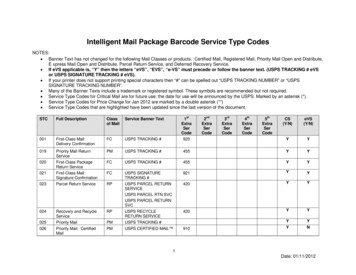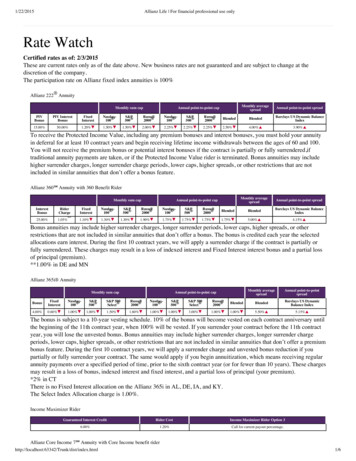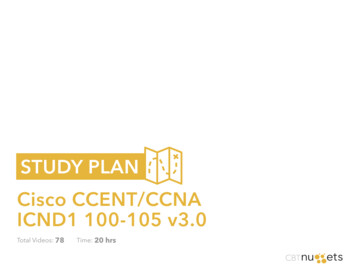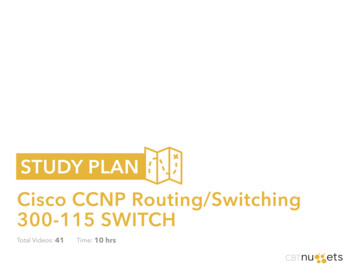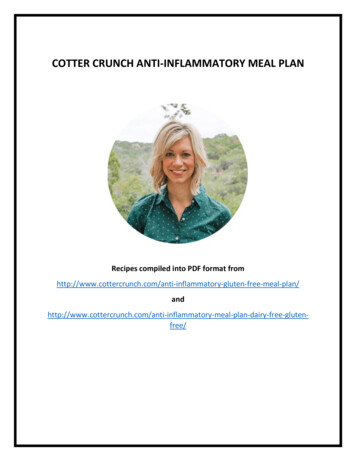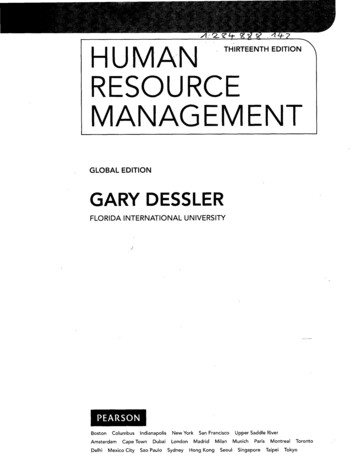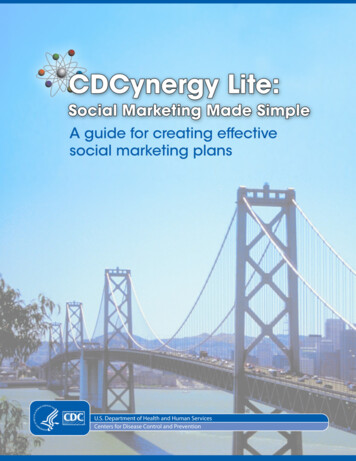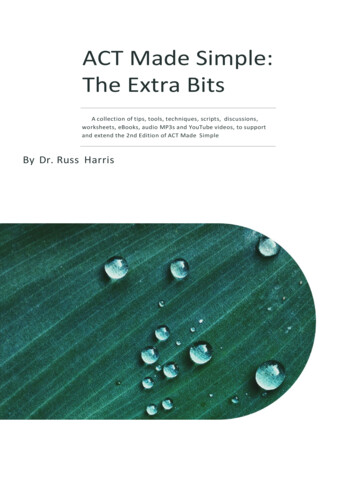
Transcription
ACT Made Simple:The Extra BitsA collection of tips, tools, techniques, scripts, discussions,worksheets, eBooks, audio MP3s and YouTube videos, to supportand extend the 2nd Edition of ACT Made SimpleBy Dr. Russ HarrisMindfulness & Trauma
ACT Made Simple: The Extra BitsHow To Use This E-bookIn the 2nd edition of ACT Made Simple, you’ll find an “extra bits” textbox near the end of most chapters. You candownload all the materials mentioned in those boxes – plus quite a few extra ones I’ve thrown in for good measure from the links in this document.Please feel free to share all these resources with colleagues, students, trainees and clients.On the last page of this document you’ll find information about online training in ACT and online resources you canuse with your clients to “supercharge” your sessions.Free Study Group On FacebookThe ACT Made Simple Facebook group includes thousands of practitioners from around the world. It’s open to anytherapist, coach, counsellor, doctor, nurse, physio, dietitian, OT, youth worker, BCBA or any other type of healthprofessional who wishes to discuss, share resources, ask questions, explore ideas, or help and support others tolearn more about the practical application of Acceptance & Commitment Therapy. And more than that, it's aspace where we can deepen our passion for ACT, and apply it to ourselves, so we can grow not just aspractitioners but as human beings.You can find us here: w To Join The Free Study GroupFirst, the good news: There will be a permanent record of this study group, always available, in the ACT MadeSimple Facebook group. (Yes, it will be available for the rest of time, until the heat death of the universe.) You willbe able to access this material at any time from the ‘Announcements’ section on the FB group. You can also use theFacebook search function. Simply go to the search bar and enter the hashtag for the chapter you want – e.g. enter#ACTMadeSimpleChapter1 or #ACTMadeSimpleChapter2 etc.If you are reading this after November 2019, the study group will have finished and you can access it as above.If you are reading this before those dates The study group started in June 2019 and will run weekly for approximately 4 months – ending sometime in November 2019. It’s not “live” like a webinar. We read chapters and then discuss them on FB. So if you want tojoin us, there’s nothing you need to sign up for; all you need do is join ACT Made Simple on FB and once you’re in,keep an eye out for each weekly announcement about what we’re doing in the study group that week.Page 2 Russ Harris 2019 www.imlearningact.com
ACT Made Simple: The Extra BitsChapter 1:The Human ChallengeDiscussion: The Matrix & The Choice Point - Similarities & DifferencesWorksheet/Diagram: The Choice PointDiagrams: The Hexaflex & TriflexYouTube Animation: The Choice Point: A Map For LifeYouTube Animation: How The Mind EvolvedYouTube Animation: The 3 Happiness MythsChapter 2: Getting HookedWorksheet: Six Core Pathological Processes in ACT (to “unpack” any issue or diagnosis)Worksheet: ACT Case FormulationChapter 3:“Mindfulness” and Other Dodgy WordsYouTube Animation: 5 Mindfulness MythsChapter 6:What’s the Problem?Worksheet: Dissecting The ProblemWorksheet: The Bull’s EyeWorksheet: ACT Case FormulationTips: Establishing Behavioral Goals In Tricky Cases.Tips: When Other People Are The ProblemTools: How To Set An AgendaTools: How To Structure A SessionChapter 7:Where Do I Start?Worksheet: Vitality Vs. Suffering DiaryWorksheet: Problems & ValuesChapter 8: Creative What?!Worksheet: Vitality Vs. Suffering DiaryWorksheet: Join the DOTSChapter 9: Drop the StruggleWorksheet: The Daily StruggleTips: Normalize Clients’ Struggles With Their EmotionsTips: Tricky Reactions To “Pushing Away Paper”YouTube Animation: The Struggle Switch MetaphorYouTube Animation: The Polygraph MetaphorPage 3 Russ Harris 2019 www.imlearningact.com
ACT Made Simple: The Extra BitsChapter 10: Dropping AnchorAudio MP3 - dropping anchor: 40 secondsAudio MP3 - dropping anchor: 2 minutesAudio MP3 - dropping anchor: 7 minutesAudio MP3 - dropping anchor: 11 minutesTips: When to “sit” with feelingsTips: How to drop anchor in bedTips: Being flexible with dropping anchorTips: If the client says dropping anchor is “not working” or “I don’t get it”Tips: Working with dissociationTips: Distraction versus flexible attentionScript: Dropping anchor with flashbacksResources: The ACT Companion smartphone app & contacting the present momentChapter 11: Notice That ThoughtTips: Tricky reactions to the Hands as Thoughts exerciseTips: How to “Make the link” when you see fusion in sessionTips: Shatter the illusion that our thoughts controlChapter 12: Deeper into DefusionTips: How to tell when your clients are defusingTechnique: Titchener’s RepetitionChapter 13: The Defusion SmorgasbordDiagram: Summary of Common Defusion TechniquesTips: Defusion From ImagesTips: Additional defusion methodsTips: Fusion & experiential avoidance in everyday languageWorksheet: The Getting Hooked WorksheetResources: How to use the ACT Companion app for defusion.YouTube Video: Thanking Your MindYouTube Animation: The Sushi TrainChapter 15: Leaves, Streams, Clouds, and SkyAudio MP3: “Hearing Your Thoughts”Chapter 16: “Technique Overload” and Other PerilsTool: Create your own ACT tool kitChapter 17: Being PresentScripts: Mindful breathing, mindful drinking, mindful eating, mindful body scanAudio MP3: Notice Your HandWorksheet/Handout: Engaging, Savoring, and Focusing In Daily LifeDiscussion: The Mindful TherapistTips: Clients with low mood who ruminate and worryResources: The ACT Companion smartphone app & contacting the present momentPage 4 Russ Harris 2019 www.imlearningact.com
ACT Made Simple: The Extra BitsChapter 18: Hold Yourself KindlyScripts: Additional self-compassion exerciseseBook: Tricky client reactions and other barriers to self-compassionScript & Tips: Inner-child imageryDiscussion: The ACT take on “forgiveness”Resources: Using the ACT Companion app for acceptance and self-compassionChapter 19: Know What MattersTechniques: Additional values exercisesWorksheet: Checklist of 40 Common ValuesWorksheet: Common Values in 4 domainsWorksheet: The Life CompassDiscussion: What If The Client Has Destructive values?Discussion: Values vs desires, wants, needs, feelings, virtues, morals, and ethicsDiscussion: More examples of goals versus valuesTips: “Stepping stone” answers to questions about valuesTips: How to bring in values in later sessionsYouTube animation: Values versus goalsResources: Using the ACT Companion app for values & committed actionChapter 20: What If Nothing Matters?Tips: A 5-step plan for values conflictsTips: Difficult dilemmas & tough decisionsDiscussion: Desire For Power & More Abou t Destructive valuesClinical example: Using the choice point with fusion and avoidance during values workChapter 21: Do What It TakesTips: Excessive focus on desired outcomesTips: Fusion that arises while goal settingWorksheets: Scheduling & monitoring & pleasant activitiesWorksheet: SMART Goal-SettingHandout: The challenge formula with explanatory textResources: Using the ACT Companion app for values & committed actionChapter 22: Fifty Shades of AcceptanceTips: Enhance the acceptance elements in mindfulness; wade through the swampWorksheet: Struggling vs. Opening UpDiagram: Summary of common acceptance techniquesTools: Additional metaphors for acceptanceTechniques: Emotion surfing and urge surfingDiscussion: How childhood programming set us up to struggle with our feelingsTips: How to tackle the belief that our thoughts and emotions control our actionsTips: Titrating acceptance so clients aren’t overwhelmed.Page 5 Russ Harris 2019 www.imlearningact.com
ACT Made Simple: The Extra BitsChapter 23:Emotions as AlliesTips: How to help clients figure out when it’s useful—or not—to focus on their emotionseBook: How to work with dissociationeBook: Emotion regulation in ACT.YouTube animation: The sympathetic and parasympathetic nervous systemsYouTube animation: Three main parts of the brainYouTube animation: The limbic brain and its role in traumaYouTube animation: The three meanings of ‘freeze’Chapter 24: What’s Stopping You?Worksheet: HARD BarriersTips: Functional Analysis Made SimpleChapter 25: The Noticing SelfCorrection: on the bottom of page 291, there is an error. I wrote this:To add further to terminology confusion, many textbooks refer to the experience of fusion with yourself-concept with terms such as “self-as-story” or “self-as-content.”The error is that the terms “self-as-story” and “self-as-content” do not necessarily imply fusion. Ishould have written this:To add further to terminology confusion, many textbooks refer to a sense of self that arises when youidentify with your self-concept and regard it as “who you are”. This sense of self is often called “self-asstory” or “self-as-content.” We can fuse with or defuse from this sense of self.Script: Chessboard metaphorYouTube animation: Chessboard metaphor (Internal Struggles)Discussion: Therapy versus mysticism & “Is this the soul?”Tips: What to do if clients can’t access a noticing self.Chapter 26: Flexible ExposureTool: Measuring Response Flexibility in ExposureTools: Materials on exposure: motivation tips, exposure hierarchy worksheet, exposure recordResources: To learn more about how to do formal, explicit exposure in ACT, I recommend the textbook“ACT for Anxiety Disorders” by Eifert & Forsyth, and/or either of my online courses on “ACT for Depression &Anxiety Disorders” or “ACT for Trauma”, both available at: www.ImLearningACT.comChapter 27:Cognitive FlexibilityDiscussion: Defusion Vs DisputationDiscussion: The Role of Self-talk in ACTDiscussion: Positive thinking and cognitive restructuringPage 6 Russ Harris 2019 www.imlearningact.com
ACT Made Simple: The Extra BitsChapter 28: Shame, Anger, and Other “Problem” EmotionsScript: Urge surfing & Emotion SurfingeBook: Working with angerScript: Inner-child imagery exerciseeBook: Working with DissociationeBook: Working with Body PostureChapter 29: Flexible RelationshipsWorksheets: Worksheets for ACT with common relationship issuesChapter 31: A Quick Guide to Getting UnstuckTips: An ACT Practitioner’s Guide To Getting Unstuck From Just About AnythingOnline Training in ACTReading a textbook is a good start and online training can take you so much further. I offer arange of beginners and advanced level interactive online courses – which include specializedcourses in depression anxiety disorders, trauma, adolescents, and brief intervention.For more details, see: www.ImLearningACT.comHow To “Supercharge” Your SessionsThe Happiness Trap Online Program is a great way to “supercharge” your sessions and helpyour clients make progress faster. This entertaining yet ext r em e ly pr act ical s elf de ve lo p m e nt cours e in ACT can truly boost your therapy, coaching or counselling sessions.Comprised of engaging videos, audio MP3s, written materials, and playful animations,the program is designed to keep people int er est ed, motivated, and actively participating.To get a quick overview of the program content, take a look at these delightful visualsummaries of each week: Visual SummariesACT practitioners can use the Happiness Trap Online Program as a powerful adjunct to (not areplacement for) clinical work or coaching. If this appeals, you can join (free of charge) ourACT Practitioners’ Community, which will give you a unique discount code, that enablesyour clients to access the program at low cost, plus support materials to help you use the course(in part or whole) with clients.You can either use the whole program, or selectively use just the most relevant parts of it,for psychoeducation, homework assignment, experiential work, skills development,overcoming resistance, motivation, inspiration and more. It’s especially useful to reinforcewhat you did in today’s session or prepare in advance for the next one.To find out more, go to: erPage 7 Russ Harris 2019 www.imlearningact.com
Mindfulness & Trauma ACT Made Simple: The Extra Bits . A collection of tips, tools, techniques, scripts, discussions, worksheets, eBooks, audio MP3s and YouTube videos, to support and exten
